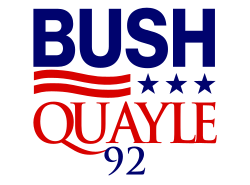| George H. W. Bush for President 1992 | |
|---|---|
 | |
| Campaign | 1992 Republican primaries 1992 U.S. presidential election |
| Candidate | George H. W. Bush 41st President of the United States (1989–1993) Dan Quayle 44th Vice President of the United States (1989–1993) |
| Affiliation | Republican Party |
| Status | Announced: October 11, 1991 Presumptive nominee: May 5, 1992 Official nominee: August 20, 1992 Lost election: November 3, 1992 Left office: January 20, 1993 |
| Headquarters | Houston, Texas |
| Key people |
|
| Receipts | US$101,936,902[1] |
| Slogan | Don't Change the Team in the Middle of the Stream[2] |
The 1992 presidential campaign of George H. W. Bush was an unsuccessful re-election campaign for 1992 United States presidential election by incumbent president George H. W. Bush, who had taken office on January 20, 1989.[3] Bush and incumbent vice president Dan Quayle were defeated by Democratic presidential nominee Bill Clinton and vice presidential nominee Al Gore.[4] Bush, a Republican president and former vice president under Ronald Reagan, launched his presidential bid on October 11, 1991 and secured nomination for his re-election on August 20, 1992. He was challenged in the Republican primaries by former White House Communications Director Pat Buchanan, who received less than one percent of the delegates in the Republican National Convention.[5]
With a coalition victory in the Persian Gulf War and high approval ratings, Bush's re-election initially looked likely; however, he was criticized by many conservatives for breaking his pledge of never raising taxes.[6] He felt the economy would be the deciding factor in the election and could even overshadow the success of Operation Desert Storm. Early counting of ballots in the New Hampshire primary favored Buchanan,[7] but the final results gave a victory to Bush.[8] It was a strong showing by Buchanan, as his score nearly matched Eugene McCarthy's protest vote against Lyndon B. Johnson in 1968.[9] During the convention, it was speculated that Bush might drop Quayle from the ticket due to his relatively low polling performance,[10] but Bush was unwilling, asserting that removing his 1988 choice from the 1992 ticket would be an implicit admission that choosing Quayle had been a mistake.[10]
Meanwhile, Democrats nominated Bill Clinton, the governor of Arkansas as their presidential nominee, with Al Gore, a senator from Tennessee, as his running mate.[11] Texas billionaire Ross Perot ran as an independent candidate; at one point Perot had a clear lead over the major-party candidates in the polls.[12] During the campaign, Bush emphasized his foreign policy success, but as the economy went into a recession, his popularity fell. He conducted a whistle stop tour on a train named Spirit of America and participated in a series of three presidential debates.[13] Clinton won the election, taking 43 percent of the popular vote and 370 electoral votes, while Bush won 37.5 percent of the popular vote and 168 electoral votes. Perot won 19% of the popular vote, one of the highest totals for a third-party candidate in U.S. history, but no electoral votes.[14] Bush left office with a 56% approval rating and 37% disapproval rating.[15]
- ^ "Bush, George – Candidate overview". FEC.gov. Archived from the original on April 28, 2021. Retrieved April 28, 2021.
- ^ Friedman, Nancy (September 17, 2020). "A Slogan in Every Pot!". Visual Thesaurus. Archived from the original on July 13, 2021. Retrieved July 13, 2021.
- ^ "George H. W. Bush: Campaigns and Elections Miller Center". millercenter.org. October 4, 2016. Archived from the original on June 6, 2021. Retrieved April 25, 2021.
- ^ "United States Presidential Election of 1992 United States Government". Encyclopedia Britannica. Archived from the original on June 6, 2021. Retrieved April 25, 2021.
- ^ Toner, Robin (March 11, 1992). "The 1992 Campaign: Primaries and Caucuses; Clinton Takes Florida Easily, Sweeping Primaries in South; Protest Votes Still Dog Bush". The New York Times. ISSN 0362-4331. Archived from the original on June 6, 2021. Retrieved April 25, 2021.
- ^ "Broken Presidential Campaign Promises Since 1916". Spokesman.com. Archived from the original on June 6, 2021. Retrieved May 22, 2021.
- ^ Connell, Christopher (February 20, 1992). "Bush Ready to Take on Buchanan". Pittsburgh Post-Gazette. Archived from the original on June 6, 2021. Retrieved April 30, 2021 – via Google News.
- ^ Toner, Robin (February 19, 1992). "The 1992 Campaign: New Hampshire; Bush Jarred in First Primary; Tsongas Wins Democratic Vote". The New York Times. ISSN 0362-4331. Archived from the original on April 25, 2021. Retrieved April 25, 2021.
- ^ Meacham 2015, p. 501.
- ^ a b Meacham 2015, p. 507.
- ^ Balz Jr., Dan; Dionne, E. J. (June 3, 1992). "Clinton Secures Party Nomination". The Washington Post. ISSN 0190-8286. Archived from the original on June 6, 2021. Retrieved April 25, 2021.
- ^ "Gallup Presidential Election Trial-Heat Trends, 1936–2008". Gallup.com. September 24, 2008. Archived from the original on June 6, 2021. Retrieved April 25, 2021.
- ^ Cite error: The named reference
:5was invoked but never defined (see the help page). - ^ Federal Election 92 (PDF). Federal Election Commission. 1993. p. 15. Archived (PDF) from the original on May 12, 2021. Retrieved April 25, 2021.
- ^ "Presidential Job Approval The American Presidency Project". Presidency.ucsb.edu. Archived from the original on June 6, 2021. Retrieved May 6, 2021.
© MMXXIII Rich X Search. We shall prevail. All rights reserved. Rich X Search
